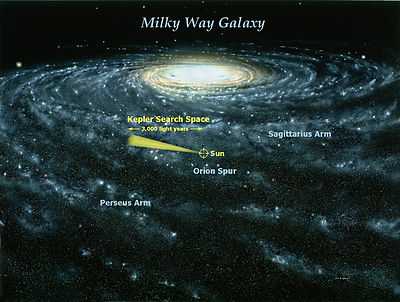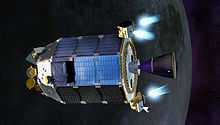Kepler-62b
| Extrasolar planet | List of extrasolar planets | |
|---|---|---|
| Parent star | ||
| Star | Kepler-62 (KOI-701) | |
| Constellation | Lyra | |
| Right ascension | (α) | 18h 52m 51.06019s |
| Declination | (δ) | +45° 20′ 59.507″ |
| Apparent magnitude | (mV) | 13.654[1] |
| Mass | (m) | 0.69 (± 0.02)[2] M☉ |
| Radius | (r) | 0.64 (± 0.02)[2] R☉ |
| Temperature | (T) | 4925 (± 70)[2] K |
| Metallicity | [Fe/H] | -0.37 (± 0.04)[2] |
| Age | 7 (± 4)[2] Gyr | |
| Physical characteristics | ||
| Radius | (r) | 1.31 (± 0.04)[2] R⊕ |
| Stellar flux | (F⊙) | 70 ± 9 ⊕ |
| Temperature | (T) | 750 |
| Orbital elements | ||
| Semimajor axis | (a) | 0.0553[2] AU |
| Eccentricity | (e) | ~0[2] |
| Orbital period | (P) | 5.714932[2] d |
| Inclination | (i) | 89.2 (±0.4)[2]° |
| Discovery information | ||
| Discovery date | 18 April 2013[2] | |
| Discoverer(s) | Borucki et al. | |
| Discovery method | Transit (Kepler Mission)[2] | |
| Other detection methods | Transit timing variations | |
| Discovery site | Kepler Space Observatory | |
| Discovery status | Published refereed article | |
| Other designations | ||
| KOI-701.02
| ||
Kepler-62b is the innermost and the second smallest discovered exoplanet orbiting the star Kepler-62, with a diameter roughly 30% larger than Earth. It was found using the transit method, in which the dimming effect that a planet causes as it crosses in front of its star is measured.[2] Its stellar flux is 70 ± 9 times Earth's.[2]

The Kepler Space Telescope search volume, in the context of the Milky Way Galaxy.
References
- ↑ "Kepler Input Catalog search result". Space Telescope Science Institute. Retrieved 2013-04-18.
- ↑ 2.0 2.1 2.2 2.3 2.4 2.5 2.6 2.7 2.8 2.9 2.10 2.11 2.12 2.13 Borucki, William J. et al. (18 April 2013). "Kepler-62: A Five-Planet System with Planets of 1.4 and 1.6 Earth Radii in the Habitable Zone". Science Express. arXiv:1304.7387. Bibcode:2013Sci...340..587B. doi:10.1126/science.1234702. Retrieved 18 April 2013.
| ||||||||||
| ||||||||||||||||||||||||||||||||||||||||||||||||||||||||
| |||||||||||||||||||||||||||||||||||||||||||
